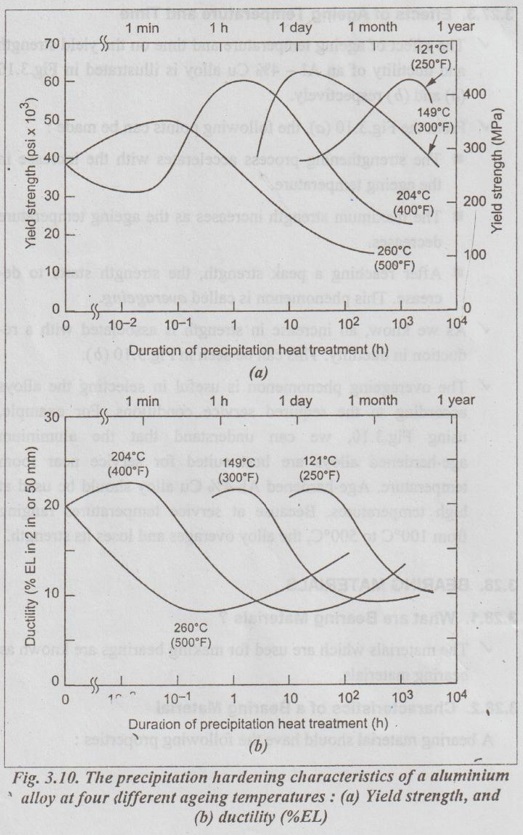The materials which are used for making bearings are known as bearing materials.
BEARING MATERIALS
1. What are Bearing Materials ?
✓ The materials which are used for making bearings are known as bearing materials.
2. Characteristics of a Bearing Material
A bearing material should have the following properties:

1. It should possess sufficient hardness and wear resistance.
2. It should have a low coefficient of friction.
3. It should be tough, shock-resistant, and sufficiently ductile.
4. It should have a sufficient melting point.
5. It should have high thermal conductivity.
6. It should have good casting qualities.
7. It should have good resistance to corrosion.
3. Bearing Materials
The widely used bearing materials are :
1. White metals,
2. Copper-base alloys,
3. Aluminium-base alloys,
4. Plastic materials, and
5. Ceramics.
The selection of a particular bearing material depends upon types of loading, running speed, and service conditions.
1. White bearing metals
✓ White bearing metals are either tin-based or lead-based alloys.
✓ All white bearing metals contain about 10% of antimony (Sb). Tin and antimony combines chemically to form an intermetallic compound SbSn. This forms small hard cubic crystals, termed cuboids. These cuboids are hard, and have low-friction properties, which constitutes the necessary bearing surface in white metals.
(i) Tin-base bearing alloys
✓ The tin-base bearing alloys are known as Babbit metals, after Isaac Babbitt, their originator.
✓ Composition: The composition of a typical 'Babbit' metal is given below:
Sb 10%, Sn 82%, Cu 4%, Pb 4%.
✓ The tin-base bearing alloys are of better-quality high-duty bearing metals than the lead-base bearing alloys.
✓ Uses: They are suitable for use in many medium- and high-duty bearing applications, particularly in the automotive industries.
(ii) Lead-base bearing alloys
✓ The lead-base bearing alloys are cheaper than tin-base bearing alloys.
✓ Composition: The composition of a typical lead-base bearing. alloy is given below:
Sb 13%, Sn 12%, Cu 0.75%, As 0.25%, Pb 74%
✓ Uses: They are used for low pressure/low speed bearing applications.
2. Copper-base bearing alloys
✓ Copper-base bearing alloys include:
1. Plain tin bronze - Cu 85%, Sn 15%
2. Phosphor bronzes - Cu 88%, Sn 10%, P 0.3%, Zn 1%, Pb 0.7%
3. Leaded bronzes - Cu 75%, Sn 5%, Pb 18%, Ni 2%
4. Sintered bronzes - Cu power 90%, Sn powder 10%
✓ The phosphor bronzes provide improved load bearing capacity.
✓ The leaded bronzes are less strong than other bearing bronzes. But they will sustain higher loads at higher speeds than white metals.
✓ Sintered bronzes are made by compacting and sintering Cu-Sn powder. They are usually self-lubricated.
✓ Uses:
1. Leaded bronzes are used in the manufacture of main bearings in aero-engines, and for automobile and diesel crankshaft bearings.
2. Self-lubricating sintered bearings are used widely in the automobile industries and in domestic equipments such as vacuum cleaners, washing-machines, extractor fans, and audio equipment (where long service with a minimum of maintenance is required).
3. Aluminium-base bearing materials
✓ Aluminium-base alloys containing tin, copper, and nickel are widely used as bearing materials.
✓ Nowadays, more expensive tin-base bearing alloys are replaced by aluminium-base bearing alloys.
✓ Composition: The composition of a typical Al-Sn alloy is given below:
Sn 5.5-7.0%, Cu 0.7-1.3%, Ni 0.7-1.3%, Balance is Al.
✓ Uses: They are used as main and big-end bearings in he automobile design.
4. Plastic bearing materials
✓ The well-known plastic bearing materials are:
1. Nylons (polyamides), and
2. Poly tetra fluro ethylene (PTFE or Teflon).
✓ They have very low coefficients of friction.
✓ Uses: They are used for low load applications, particularly where oil lubrication is impossible or undesirable.
5. Ceramic bearing materials
✓ Ceramic materials are used as bearings in small precision instruments, for example jewel bearings in watch movements.
✓ Modern industrial ceramics such as alumina are used as bearings in large speed precision movements.
Note
✓ Super alloy is a general term used to describe the nickel-base and cobalt-base alloys which have been developed for use at elevated temperatures.
✓ Super alloys produce a combination of high strength at elevated temperatures, resistance to creep at temperatures upto 1000°C, and resistance to corrosion.
✓ Typical applications of super alloys include vanes and blades for turbine and jet engines, heat exchangers, chemical reaction vessel components, and heat- treating equipment.
No comments:
Post a Comment